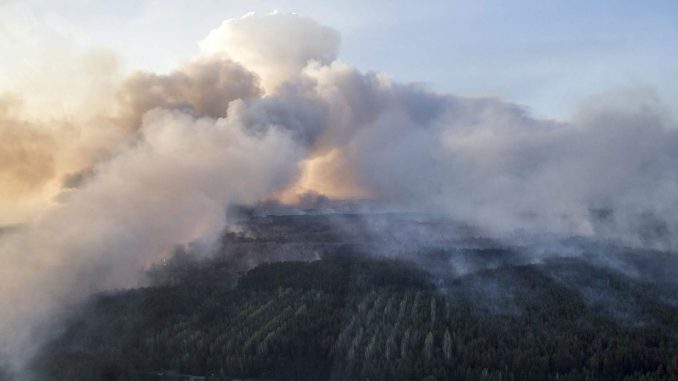
Ecology experts have warned that the smoke from burning forests in the Chernobyl exclusion zone is capable of spreading contaminants far and wide even after the fire has been stopped.
The Ukrainian National Guard was put on high alert Tuesday due to the worsening of forest fires around the crippled Chernobyl nuclear power plant,

BYPASS THE CENSORS
Sign up to get unfiltered news delivered straight to your inbox.
You can unsubscribe any time. By subscribing you agree to our Terms of Use
Latest Video
On Wednesday, the country’s Emergency Ministry said the spread of the fire had been stopped while firefighters were containing the remaining flames.
RT reports: The fire occurred within 30 kilometers of the Chernobyl power plant, inside the exclusion zone which was abandoned and cordoned off almost 30 years ago. In 1986, an explosion and fire in Chernobyl’s Reactor 4 caused a release of radioactive particles into the air, which contaminated the surrounding area and caused an increase in radiation levels in Russia, Ukraine, Belarus and across Europe. It was the worst ever nuclear disaster in terms of casualties and clean-up costs. The crippled reactor itself was sealed under a sarcophagus of reinforced concrete.
Although the sarcophagus remains untouched by the fire, decades-old contaminants could still be released and travel far and wide, borne aloft by the smoke, nuclear safety expert John H. Large told RT:
“Brush fires and forest fires were the greatest concern in terms of the means by which you can disperse a secondary radiological impact from the original dissipation that occurred in 1986,” he said.
John went to Chernobyl in 2006 to assess the situation there and spoke to dozens of scientists working on containing the contamination.
“In the exclusion zone and further away you have an area that has been abandoned for farming, abandoned for man management,” John says. “That means you’ve got lots of brush and young wood growing out of control, and that means there’s a big fuel load to have a fire.”
He says the high temperatures and volumes of smoke produced in a forest fire can take contaminants hundreds of kilometers away from the exclusion zone: “Radiation really doesn’t respect any international boundaries.”
Forest fires have happened in the area before, but have never been so serious, Timothy Mousseau, biology professor at the University of South Carolina, told RT:
“Previous forest fires had re-released about eight percent of the radiation from the original catastrophe. The fire that we’re seeing today seems to be on a much larger scale, and so we could see a re-dispersion of a very significant component of the original radiation.”
Another problem is that as the trees that have absorbed contaminants burn up and release smoke, this turns radioactive particles into a much more dangerous form than if they simply lie in the ground.
“Internal radiation from inhalation – in other words, if you inhale something radioactive and it gets inside you – is very much more dangerous than just the background radiation that comes off the ground,” says Christopher Busby, the scientific secretary of the European Committee on Radiation Risks.


